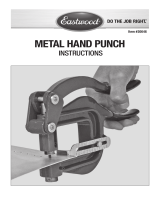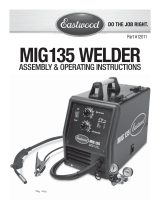Page is loading ...

3 GALLON, OILLESS
PANCAKE COMPRESSOR
INS TRU CTI ONS
Item #31289

2 Eastwood Technical Assistance: 800.544.5118 >> techelp@eastwood.com
The EASTWOOD 3 GALLON, OILLESS PANCAKE COMPRESSOR, with an Integral Air Regulator, efficiently supplies all compressed air requirements for
operating Eastwood Powder Coating Gun systems as well as most airbrushes. The compact, efficient design also works well with some lower demand
air tools, tire inflation, blow guns and many other compressed air applications.
SPECIFICATIONS
Power Requirement: 120V 60Hz, 2.5-amp
Motor Horsepower: 1/3 hp
Tank Size: 3 gallon
Air Delivery: 1.0 SCFM @ 40 PSI, 0.6 SCFM @ 90 PSI
Cut-in Pressure: 85 PSI
Cut-out Pressure: 100 PSI
Max. Pressure: 100 PSI
Power Cord: 6ft, 3-prong grounded, 18 AWG
DANGER indicates a hazardous situation which, if not avoided, will result in death or serious injury.
WARNING indicates a hazardous situation which, if not avoided, could result in death or serious injury.
CAUTION used with the safety alert symbol, indicates a hazardous situation which, if not avoided, could result in minor or moderate injury.
NOTICE is used to address practices not related to personal injury.
SAFETY INFORMATION
The following explanations are displayed in this manual, on the labeling, and on all other information provided with this product:
READ INSTRUCTIONS
• Thoroughly read and understand this manual before using.
• Save for future reference.
FIRE OR EXPLOSION HAZARD!
• Never spray flammable liquids in a confined area. It is normal for the motor and pressure switch to produce sparks while operating.
If sparks come into contact with vapors from gasoline or other solvents, they may ignite, causing fire or explosion. Always operate
the compressor in a well–ventilated area. Do not smoke while spraying. Do not spray where sparks or flame are present.
Keep compressor as far from spray area as possible.

SAFETY INFORMATION
BURSTING HAZARD!
• Tank can rupture causing personal injury. Failure to drain tank can lead to corrosion and rupture. Drain moisture from the tank
on a daily basis.
• Pull the Pressure Relief Valve ring daily to test that the valve is functioning properly, and to clear the valve of any possible obstructions.
• Do not weld, drill or modify the air tank of this compressor. Welding or modifications on the air compressor tank can severely
impair tank strength and cause an extremely hazardous condition.
• Check the manufacturer’s maximum pressure rating for air tools and accessories. Compressor outlet pressure must be regulated
so as to never exceed the maximum pressure rating of the tool. Relieve all pressure through the hose before attaching or
removing accessories.
• Do not adjust the Pressure Relief Valve for any reason. The Pressure Relief Valve has been pre-set at the factory for the maximum
safe pressure of this unit. Personal injury and/or property damage may result if the relief valve is tampered with.
• Use only hose, pipe and fittings rated for compressed air distribution lines.
ELECTRICAL SHOCK HAZARD!
• Never use an electric air compressor outdoors when it is raining or on a wet surface, as it may cause an electric shock.
• Compressor plugs must match the outlet. Never modify the plug in any way. Do not use adapter plugs with grounded compressors.
Standard plugs and matching outlets will reduce risk of electric shock.
INJURY HAZARD!
• This unit starts automatically. ALWAYS shut off the compressor, remove the plug from the outlet, and bleed all pressure from the tank
before servicing the compressor, and when the compressor is not in use. Do not use the unit with the shrouds removed. Serious injury
could occur from contact with moving parts
• To provide proper ventilation for cooling and prevent overheating, the compressor must be kept a minimum of 12 inches (31 cm) from
the nearest wall, in a well–ventilated area. Do not cover compressor while in use.
To order parts and supplies: 800.345.1178 >> eastwood.com 3

4 Eastwood Technical Assistance: 800.544.5118 >> techelp@eastwood.com
COMPRESSOR SET UP
An initial new compressor break-in procedure must be performed
for best performance and maximum pump life. To do so:
1. With the Compressor unplugged, Insert a male quick
disconnect fitting (NOT INCLUDED) into the installed
female Quick Disconnect (FIG 1).
2. Open the Pressure Regulator fully (FIG 2).
3. Make sure the Power Switch is in the “OFF” position.
4. Plug the Power Cord into an appropriate 120 VAC, 15 Amp
grounded outlet.
5. Move the Power Switch to the “ON” position.
6. Allow the Compressor to run for 30 minutes. Air will
discharge freely from the male quick disconnect fitting.
7. After 30 minutes, move the Power Switch to the “OFF”
position and unplug the Power Cord.
8. Remove the previously installed male quick
disconnect fitting.
9. The Compressor is now ready for use.
COMPRESSOR OPERATION
1. Before each use, pull and release the Pressure Release
Safety Valve to verify it is not stuck.
2. Plug the power cord into an appropriate 120 VAC, 15 Amp
grounded outlet.
3. Move the Power Switch to the “ON” position.
4. Allow the Tank to fill to 85 PSI before each use. With the
Air Compressor turned on, operation is automatic and
under the control of the internal Pressure Controller. It will
turn off @ 100 PSI and automatically restart @ 85 PSI.
PRESSURE REGULATOR
ADJUSTMENT
Set the appropriate air pressure output based on the demands of
the air tool being used.
1. Turn the Pressure Regulator Adjustment knob to the left
(Counter-Clockwise) to decrease output air pressure; to
the right (Clockwise) to increase the output air pressure
(FIG 2).
2. The output air pressure setting will be indicated on the
Output Air Pressure Gauge.
NOTE: The Gauge located on the Left of the Control
Panel indicates Tank Pressure while the Gauge located
on the Right indicates the Regulator Controlled Output
Pressure (FIG 3).
FIG. 1
FIG. 2
Female Quick
Disconnect Fitting
✓
Male Quick
Disconnect Fitting
(not included)
✓
Open
FIG. 3
Tank Pressure Regulated
Output Pressure

To order parts and supplies: 800.345.1178 >> eastwood.com 5
FIG. 4
USING THE PRESSURE RELEASE
SAFETY VALVE MANUALLY
In addition to emergency over pressure relief function, the
Pressure Release Safety Valve can be used when rapid tank
air pressure release is desired. To do so:
1. Move the Power Switch to the “OFF” position and
unplug Power Cord.
2. Pull and hold the Air Release Safety Valve ring to
release pressure from the Tank (FIG 4).
3. When all pressure is released, release the ring on
the Air Release Safety Valve.
CONDENSATION DRAIN
In normal use particularly in humid environments, moisture will
condense and collect in the tank. It must be used after each use
to drain all accumulated moisture. Failure to do so can cause
internal tank corrosion, perforation and ultimate failure. Tank
moisture draining procedure:
1. Move the Power Switch to the “OFF” position and unplug
Power Cord.
2. Pull and hold the Air Release Safety Valve ring to release
pressure from the Tank until the Tank Pressure Gauge
reads less than 20 PSI (FIG 4).
3. Release the ring.
4. Slowly rotate drain valve counterclockwise to open
(FIG 5). Only slightly open the water Drain Valve to
blow air and moisture out of the Tank.
5. Tilt tank to drain moisture from tank into a
suitable container.
Opening it all the way or too quickly will cause
contaminated water to be blown out at high velocity.
Wear appropriate eye protection.
FIG. 5
Condensate is a polluting material and should be
disposed of in compliance with local regulations. If
drain valve becomes clogged, release all air pressure,
remove and clean valve, then reinstall.
Release Pressure
✓
Open Close

6 Eastwood Technical Assistance: 800.544.5118 >> techelp@eastwood.com
FIG. 6
THERMAL BREAKER
RESET BUTTON
As long as the SCFM capacity (1.0 SCFM @ 40 PSI, 0.6 SCFM
@ 90 PSI) of the Eastwood 3 Gallon Oilless Pancake Compressor
is not exceeded, it is capable of running continuous automatically
controlled on/off cycles. If the SCFM demands are exceeded,
the Compressor will run continuously in efforts to meet demand.
If this occurs, the motor will overheat and the Thermal Protec-
tion Breaker will activate and cause the motor to shut off. If this
should occur, allow the motor to cool then press the black Reset
Button located next to the ON/OFF switch (FIG 6).
NOTE: The motor will only start when it has cooled sufficiently.
MAINTENANCE
IMPORTANT NOTE: The following maintenance should be performed before each use:
• Inspect tank and fittings for damage or leaks.
• Drain moisture from tank.
• Test Pressure Relief Valve.
• Clean dirt and debris from motor air cooling slots.

To order parts and supplies: 800.345.1178 >> eastwood.com 7
PROBLEM CAUSE CORRECTION
Does Not Run
When Switch
is Turned On
No Power
Check 120 VAC power source and plug connection.
Check for tripped Thermal Protection Breaker and overheated motor condition.
Compressor
Motor Stops
Running
Motor Overheated and Thermal
Protection Protection Breaker Tripped
Wait for motor to cool , then press Thermal Protection Breaker Button.
Compressor
Runs Too
Slow/Develops
Low Power
Excessive Voltage Drop
Under-sized and/or too long of an extension cord used.
Use only 16 Gauge or larger cord and limit length to 25’.
Compressor
Runs
Constantly
Excessive Air Supply Demand Do not exceed 1.0 SCFM @ 40 PSI or 0.6 SCFM @ 90 PSI.
Air Leak at Fitting or Hose Stop compressor use, locate leak and perform repair.
Motor
Overheats
Excessive Air Supply Demand Do not exceed 1.0 SCFM @ 40 PSI or 0.6 SCFM @ 90 PSI.
Dirt and Cutting Debris Buildup in Motor
Cooling Air Slots
Use a brush or compressed air to remove debris.
TROUBLESHOOTING

© Copyright 2016 Easthill Group, Inc. 5/16 Instruction Item #31289Q Rev. 0
If you have any questions about the use of this product, please contact
The Eastwood Technical Assistance Service Department: 800.544.5118 >> email: techelp@eastwood.com
PDF version of this manual is available online >> eastwood.com/31289manual
The Eastwood Company 263 Shoemaker Road, Pottstown, PA 19464, USA
US and Canada: 800.345.1178 Outside US: 610.718.8335
Fax: 610.323.6268 eastwood.co
OPTIONAL ITEMS
#13958 Air Hose
#34066 Disposable Air Filter
#13956 Quick Coupler Set
#13957 Mini Blow Gun Set
#11476 Compact Infrared Thermometer
#10027 High Temp Fiberglass Masking Tape
#21669 High Temp Silicone Masking Tape
#43045 0.041” Stainless Steel Hanging Wire
#58041 High-Temp Silicone Masking Plugs and Caps
#14104 Eastwood Beginner's Powder Coating Handbook
#15635 Eastwood Bench-Top Powder Coating Oven
#11676 Eastwood Dual-Voltage Powder-Coating Gun
#10198 Eastwood Original Powder-Coating Gun
/











